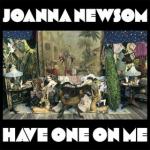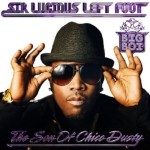We celebrate the end of the year the only way we know how: through lists, essays, and mixes. Join us as we explore the music and films that helped define the year. More from this series
-
-
 10. Kanye West
10. Kanye West
My Beautiful Dark Twisted Fantasy
[Roc-A-Fella/Def Jam]
Is it weird to use this space to point out that Kanye West and Sufjan Stevens essentially made the same record this year? Both My Beautiful Dark Twisted Fantasy and The Age of Adz tapped into that scary, sloppy, “let’s party like things are fucked, because they are” zeitgeist of 2010 in a manner refused by most of this year’s beach-’n’-weed pop. Like Sufjan, Kanye’s disarmingly obsessive mingling of high- and low-tech sounds and claustrophobically maximal approach to arrangement turned party jams into tirades and tirades into party jams. Both men dropped out of sight for a while after a crisis or two, questioned music delivery methods in 2010, assembled giant bands to flesh out their larger-than-life treatises on authority and authenticity, and reconciled God with their own egos using the lingua franca of pop-up ads. Now, consider how remarkable it is that West’s closest artistic contemporary in 2010 is a Christian singer-songwriter. Sure, the success of that analogy says something about this site’s rock-leaning background. But it also holds a mirror up to the cannibalistic, mouse-click-happy equalizers of culture that we’ve become, which in turn betrays the very reason that Fantasy put him on this list: Kanye West has gotten so big that he’s indie.
• Kanye West: http://kanyewest.com
• Roc-A-Fella/Def Jam: http://islanddefjam.com/runaway/rocafella
• TMT Review: http://tinymixtapes.com/music-review/kanye-west-my-beautiful-dark-twiste…
-
-
 09. Deerhunter
09. Deerhunter
Halcyon Digest
[4AD]
I listened to Halcyon Digest more than any other record this year, but I spent most of that time wondering what made it different from previous Deerhunter releases, a back catalog that I conceded sounded fine, but just didn’t work for me. I eventually convinced myself that it was the first excellent Deerhunter record they had released. But was that true? I now have a sneaking suspicion that I’ve been duped, that by finally embracing the soft pop of “Coronado,” the sexy grooves of “Helicopter,” and the candy-coated garage rock of “Don’t Cry,” Deerhunter had stepped off the mountain and stooped low to meet me, the sloppy, slobbering idiot who had previously dismissed their work. Have I been too much of a boob to realize that Deerhunter have always been this good? It’s enough to make a music writer feel overwhelmingly self-conscious. Perhaps next year I’ll dismiss all the pap. Maybe I’ll just focus on the most challenging, obtuse stuff The Wire magazine reports and turn my back on Bradford Cox and the next 45 demo collections he’ll unleash on his blog and whatever brilliant thing Deerhunter does next. I just can’t be talked down to like this.
• Deerhunter: http://deerhuntertheband.blogspot.com
• 4AD: http://www.4ad.com
• TMT Review: http://tinymixtapes.com/music-review/deerhunter-halcyon-digest
-
-
 08. Emeralds
08. Emeralds
Does It Look Like I’m Here?
[Editions Mego]
After a slew of limited CD-Rs and cassettes, Cleveland trio Emeralds began honing their talents on more cohesive full-length discs in 2008 by distilling their adventurous noise/drone forays into a delectable, concentrated core. Sacrificing both a degree of experimentalism and the desire to fully exhaust a concept, Emeralds took 2010 as an opportunity to release the tightly focused Does It Look Like I’m Here?. From the bright synthesizer droplets of opener “Candy Shoppe” to the breathtaking centerpiece of the title track and beyond, the album represented an accessible entry point into the intersections between kosmische musik and space-synth ambience. Despite there being a clear trajectory from their first ‘proper’ LP to Does It Look Like I’m Here?, one of the most exciting aspects about Emeralds is how the perpetual struggle to get their sound to fit into a more digestible format has produced a kind of unpredictability. So perhaps this album wasn’t proof that the band is reaching a creative peak, but that the band is gestating, setting itself to transition once again.
• Emeralds: http://www.emeraldsohio.com
• Editions Mego: http://www.editionsmego.com
• TMT Review: http://tinymixtapes.com/music-review/emeralds-does-it-look-im-here
-
-
 07. Joanna Newsom
07. Joanna Newsom
Have One On Me
[Drag City]
An outsider artist no more, Joanna Newsom came into her own with Have One On Me. Rather than further develop the Ren-Faire aesthetic of 2006’s Ys or the idiosyncratic folk of The Milk-Eyed Mender, her 2004 debut, Newsom drew from an almost unthinkable (for her, at least) range of influences — Laurel Canyon 70s soft-rock, Dixieland jazz, 80s alternative, religious hymns — to create her most accomplished album to date. Newsom’s sylvan vocals still might’ve been too shrill for those not yet converted to her cult, but Have One On Me, despite its marathon length, was more accessible than anything she’d recorded previously. Stretching the Lisa Simpson-limitations of her vocal abilities was a risk, but it paid off marvelously on full-blooded songs like “Good Intentions Paving Company” and “Baby Birch.” Have One On Me was an embarrassment of riches, and those who continued to refuse its charms were only poorer for their stubborn resistance.
• Joanna Newsom: http://dragcity.com/artists/joanna-newsom
• Drag City: http://www.dragcity.com
• TMT Review: http://tinymixtapes.com/music-review/joanna-newsom-have-one-me
-
-
 06. Oneohtrix Point Never
06. Oneohtrix Point Never
Returnal
[Editions Mego]
2009 saw Daniel Lopatin come in from the cold with the release of Rifts, a compilation of three albums of analog synth explorations that showcased the sculptural possibilities of sound. In an interview with Tiny Mix Tapes, Lopatin spoke of wanting to make “beautiful, seamless figures, carved almost violently out of gigantic blocks of super heavy, solid marble.” Returnal, Oneohtrix Point Never’s debut for Editions Mego, stayed true to this artistic quest, offering eight pieces of varying dimension, contour, and texture. At its threshold stood a heavy slab of noise called “Nil Admirari,” both a refusal of wonder and a reminder of the wider chaosmos from which OPN’s music is carved. From this big bang came a calmer universe, the new works showing less angularity than their predecessors, smoother textures that encouraged the ear to drift, to explore endless surfaces. Where the infinite arpeggios of earlier works had sometimes caused a sense of panic, these pieces attained an almost Schulzian calm while still hinting at hidden depths. Like Stephen O’Malley’s cover art, the music on Returnal was illusory, ungraspable, in danger of slipping away, not through fragility but through an Escher-like infinite metamorphosis. Titles gave clues to Lopatin’s continued interest in matters temporal: “Ouroborus,” “Where Does Time Go?,” “Returnal.” With this album, Oneohtrix Point Never found a way to grow his audience while staying rooted in his own seamless time-space.
• Oneohtrix Point Never: http://www.pointnever.com
• Editions Mego: http://www.editionsmego.com
• TMT Review: http://tinymixtapes.com/music-review/oneohtrix-point-never-returnal
-
-
 05. Big Boi
05. Big Boi
Sir Lucious Left Foot: The Son of Chico Dusty
[Def Jam/Purple Ribbon]
The preposterous title to Big Boi’s solo debut is sort of emblematic of his strange position in hip-hop: It both conforms to the rap convention of overwrought album titles and subverts it with strangeness and absurdity. How Big Boi switched so easily from archetypal hustler MC to ATlien, I have no idea. I do know that the three-song run in the middle, from “Shutterbug” to “General Patton” to “Tangerine,” was the best 10 minutes in pop music I heard all year. Although the genius-level quality of the first half of the record wasn’t quite sustained to the end, Antwan Patton was never less than engaging on the mic, combining master craftsmanship with in-jokey humor that made you wish you knew the guy. Considering how long Sir Lucious was in the making, it is remarkable both how of-the-moment it sounds (“General Patton” towers and menaces like Teflon Don, for just one example) and how many zeitgeist-grabbing guests feature on the record, from Yelawolf to Janelle Monáe. Unbelievably, even the tune with Vonnegut works. An Outkast solo album in 2010 could have easily been greeted with a shrug or a groan, but Big Boi shed the excesses that sometimes bog down Outkast releases and gave us a great popular hip-hop record that is also kind of, you know, weird.
• Big Boi: http://bigboi.com
• Def Jam/Purple Ribbon: http://www.defjam.com
• TMT Review: http://tinymixtapes.com/music-review/big-boi-sir-lucious-left-foot-son-c…
-
-
 04. Flying Lotus
04. Flying Lotus
Cosmogramma
[Warp]
Steven Ellison makes music to score the bong rips of elder gods — which is to say, it’s as occasionally danceable as it is cosmic and dankly spiritual. 2010 found Flying Lotus sidebarring his usual skanky animated beats, chilling in a Venusian jazz loft with a genre-blind band of collaborators to make Cosmogramma, an ambrosiac opus that honored his blood ties to the Coltrane clan and represented a Warp-speed progression of his sound. It was a monolithic work that, while hugely acclaimed in all the right places, seemed to have escaped the wider cultural recognition it deserved. If a Thom Yorke guest spot didn’t do it, what would have? Maybe it was the pacing — the album started with a fake-out, a synth barrage that suggested material like the more bumpable Los Angeles but immediately dropped into the astral abyss that characterized Cosmogramma. The thing felt absolutely impenetrable on the first go-round, save a couple dancier tracks, like the sublime, scat-laden “Do the Astral Plane.” When asked over the past year by my friends to describe the album, the best I’ve been able to do is to say that it sounds like the future. Flying Lotus’s music is not just retrofuturistic or Aftrofuturistic. It’s full-stop futuristic, and maybe the wider world just isn’t ready for that.
• Flying Lotus: http://flying-lotus.com
• Warp: http://warp.net
• TMT Review: http://tinymixtapes.com/music-review/flying-lotus-cosmogramma
-
-
 03. Swans
03. Swans
My Father Will Guide Me up a Rope to The Sky
[Young God]
Like a supernatural weather system from M. Night Shyamalan’s stable, Swans are no ‘ornery’ 80s underground phenomenon. There’s more presence, less bluster to their sound than meets the eye. Gira and co. have mastered these clichés by styling themselves as soothsayers rather than purveyors of novelty, continuing to tell it like it is no matter how unpleasant. Swans fans tend to stick around like cussed villagers who won’t leave town in spite of imminent disaster, and their standard defense goes something like this: “It’s headwrecking — but yeah, that’s the point.” Yet however relentless they may seem, Swans have evolved over the years. My Father Will Guide Me up a Rope to The Sky retained the distinctive keyboard percussion of their last album, 1996’s Soundtracks for the Blind, but made it new. From the standout track “You Fucking People Make me Sick,” featuring Devendra Banhart and Gira’s young daughter on vocals; to the subsequent descent into Lynchian hell, where the track scraped rock-bottom with a demonic brass section writhing like a reptilian tail; to the album’s finale “Little Mouth,” which shuffled and barked in a crippled sub-country dialect; Swans’ latest created a lush, swampy sound redolent of Gira’s Angels of Light or Trevor Montgomery’s Lazarus. But this didn’t stop Gira from knocking heads together on tracks like “Eden Prison.” Swans fans: They had it comin’ to them.
• Swans:http://swans.pair.com
• Young God: http://younggodrecords.com
• TMT Review: http://tinymixtapes.com/music-review/swans-my-father-will-guide-me-rope-sky
-
-
 02. Ariel Pink
02. Ariel Pink
Before Today
[4AD]
Inevitably, most music historians will remember 2010 as the point at which Kanye finally delivered on his long-repeated mantra of “genius, genius.” But lest we forget, Ariel Pink had himself quite a year, too. Until recently, he was amidst a decade-plus stint in home-recorded obscurity/insanity prior to anyone really giving a shit (as long as Daniel Johnston, longer than Bob Pollard), quietly honing his craft to a small audience of mail-order acolytes. Then 2010 hits, and all of a sudden this cute li’l runt’s got one of the best sets in live rock, the audacity to tell some idealist mope on NPR that he’s just in it for the cash, and the dream girlfriend of just about any lady-lover reading these words. His secret? One of the very best records of the year — and perhaps the most fittingly titled. Not only did Before Today lovingly reminisce on everything from oldies Ethiopian pop to Thriller (not to mention childhood itself; I doubt I’m the only one who thinks of cartoon chase scenes once “L’Estat” gets going), but it rightly asserted that all of Pink’s lonesome hard work was in preparation for one tremendous culmination. Let’s hope this new era runs long and fruitful for the guy — but it’s gonna be hard to top a record that joins the ranks of Bee Thousand, The Soft Bulletin, and even Nevermind in the pantheon of unlikely weirdo triumphs. That’s about as good as it gets.
• Ariel Pink: http://www.arielpink.com
• 4AD: http://www.4ad.com
• TMT Review: http://tinymixtapes.com/music-review/ariel-pinks-haunted-graffiti-today
-
-
 01. Zs
01. Zs
New Slaves
[The Social Registry]
At the very end of “Black Crown Ceremony II: Six Realms,” the final movement of a two-part suite that concludes New Slaves — Zs’ second ‘proper’ full-length — the music stops abruptly, without notice, as if there were a technical glitch in the recording process. It’s an odd ending to an otherwise highly focused sonic assault, made even odder since the song up to this point had consisted of nearly 10 minutes of seamless ambient sound. While in most cases a track of this sort would simply fade out, here the aesthetic fluidity is short-circuited by its sudden absence, simultaneously highlighting the sound’s materiality and drawing attention to the medium by converting this uncomfortable after-album moment into part of the album experience itself.
This unsettling conclusion didn’t surprise anyone familiar with Zs, a collective that admits to “making music that challenges the physical and mental limitations of both performer and listener.” With abrasive guitars, discrete electronics, intricate percussion, and the growling tenor sax of founding member Sam Hillmer, the New York-based group created an album that asserted itself through denial: by straying from the typical harmonic narratives of experimental music and hanging in cold suspension; by using repetition as a tool for immediacy rather than plot; by finding presence in tension, dissonance, contrast. Listening to New Slaves, then, became an act of endurance, of sacrifice, of accepting the music for what it was doing on a visceral level rather than on a rational one. Not that an academic reading wasn’t welcome; with song titles referencing Tibetan Buddhism, medical experimentation on prison inmates at Philadelphia’s Holmesburg Prison, and perhaps, as fellow TMTer Elliott Sharp suggested, new forms of slavery, the album hinted at topics relating to power, control, the body, and transformation without requiring that the listener understand, or even care about, any of it.
While passages of intuitive noise (“Don’t Touch Me”) and unrelenting dissonance (“New Slaves”) helped characterize the album as one of the heaviest of 2010, it also tailspun into moments of tranquility (“Masonry,” the “Black Crown Ceremony” suite), providing both respite and perspective. Which is to say that the 20-minute title track available for streaming above, divorced from the context of the album, isn’t a wholly accurate representation of the album’s modus operandi (though I challenge you to find a song from 2010 that’s as toweringly complex, as gut-wrenchingly abrasive, as widely scoped as this one). And while Zs’ soundworld may consist of various genre constructions — rock, modern composition, psych, free jazz, noise, ambient, drone — the intelligent ways in which the group combined them into a whole acted to subvert rather than to reinforce. It was an inspired reach, too: comparing the harmonious opening track “Concert Black” to the unbelievably guttural sax solo at 12:45 in the eponymous centerpiece revealed how versatile the musicians in Zs are, how singular they could sound, how fucking transcendent they could be.
That such an esoteric pick topped our favorite albums of 2010 list isn’t lost on us; it’s by far the most challenging, polarizing album to make it to our #1 spot. But its uneasy placement is also strangely comforting: while it expectantly landed high on the majority of editor and reviewer lists, it also somehow nestled its way onto individual lists otherwise consisting of the likes of Yeasayer, Kanye West, and Beach House. Indeed, New Slaves was a misfit here in the same manner in which Zs, who purposefully aim to stray outside the incestuous noise-underground, are misfits in the wider music world. This is why they’re as likely to play shows with Animal Collective and Dirty Projectors as Peter Brötzman and Han Bennink, why they managed to capture the attention of Howard Stern (who formed a fake avant band in an attempt to open a show for them), why they performed on 10 separate occasions at this year’s SXSW festival, why even The New York Times and The Village Voice have cleared editorial space for them.
This must also be why New Slaves has topped a list that has historically skirted around the fringe but always somehow ended up reinforcing the prevailing “indie rock” aesthetic. Zs’ placement is exciting, then, not because it underscores the “look ma, I’m an individual!” rhetoric of capitalism, but because sometimes unexpected is better than as-expected. When comparing New Slaves to future #1 picks, the album will likely either stick out like a sore thumb or be the first in a wave of unpredictability. I’m rooting for the latter.
• Zs: http://www.zzzsss.com
• The Social Registry: http://www.thesocialregistry.com
• TMT Review: http://tinymixtapes.com/music-review/zs-new-slaves
-
-
We celebrate the end of the year the only way we know how: through lists, essays, and mixes. Join us as we explore the music and films that helped define the year. More from this series
